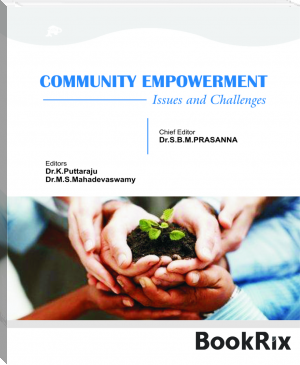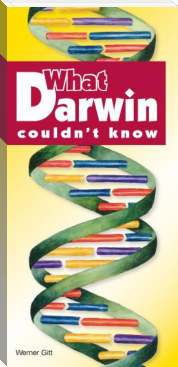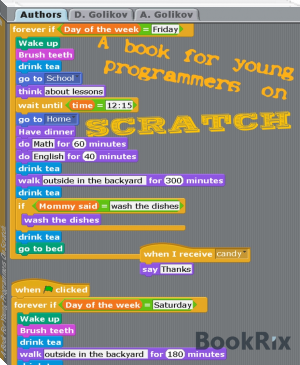Community Empowerment by Dr. SBM Prasanna, Dr. K Puttaraju, Dr.MS Mahadevaswamy (books under 200 pages TXT) 📕

Book online «Community Empowerment by Dr. SBM Prasanna, Dr. K Puttaraju, Dr.MS Mahadevaswamy (books under 200 pages TXT) 📕». Author Dr. SBM Prasanna, Dr. K Puttaraju, Dr.MS Mahadevaswamy
RANGES OF B.R.T WILDLIFE SANCTUARY
The forests are managed by the Karnataka Forest Department, an IFS (Indian Forest Service) of the rank of a deputy conservator of forests is in charge of the sanctuary. The sanctuary is divided into four ranges – Yelandur, Kollegala, Chamarajanagar and Punjur ranges, with the Kollegala range being the largest range headed by a range forest officer. More than hundreds of years, this region has been the home for the semi-nomadic Soliga tribe. The forest regions of Yelandur Chamaraja nagar and Kollegala, including the hilly tracts and foot hills of Biligirangan and Male Mahadeshwara in the southern part of Karnataka, are inhabited by nearly twenty five thousand Soliga tribal people. The Soligas were inhabited nature worshipers and reverse a large Champaka tree called Dodda Sampige in local language.
There are two local NGOs which work for integrated tribal development and biodiversity conservation in the sanctuary.
Definition of NGOs: A non-governmental organization (NGO) is any non-profit, voluntary citizens group which is organized on a local, national or international level. Task oriented and driven by people with a common interests, NGOs perform a variety of service and humanitarian functions, bring citizen concerns to governments, advocate and monitor policies and encourage political participation through provision of information. Some are organized around specific issues such as human rights, environment or health. They provide analysis and expertise, serve as early warning mechanisms and help monitor and implement international agreements; this relationship with officers and agencies of the United Nations systems differs depending on their goals, their venue and the mandate of a particular institution.
Definition of Empowerment
Empowerment is based on the idea that giving employee’s skills, resources authority, opportunity, motivation as well holding them responsible and accountable for outcomes of their actions will contribute to their competence and satisfaction.
Make someone stronger and more confident, especially in controlling their life and claiming their rights.
Definition of Tribes
Tribes are very commonly referred to as “Adivasi”.
Risley V Edwin and others used the word “Aboriginals” to mean Tribals.
Takkar Bopa an indigenous social reformer called the tribal’s “Adipraja”.
Tribes are also known as “Vanavasis”, “Aranyavasis”, “Vanyajatis” etc.
SOLIGAS
The Soligas believe their ancestors originated from the bamboo. The word Soliga says Luiz (1963) is a corruption of the Tamil word “Colai” or “Solai” (Athickest) and refers to the dense thickest in which they live, and hence Soliga is the one from the Solai. In short, both their oral history as well as linguistic analysis reveals their close relationship with nature.
This paper shall Endeavour to discuss the contribution of NGO’s towards the empowerment of Tribal Community in BiligiriranganaBetta ( B.R. Hills). It illustrates some of the significant functions and programmes of NGO’s in the upliftment of Tribal Community in the areas of Education, Health and Social Status of community living in Biligiriranga Swamy hills of Chamaraja nagar district in south Karnataka. The area of field study is located in and around BiligiriRangaSwamy Temple ( BRT) wild life sanctuary which is the home of an aboriginal tribe. They are the communities dwelling nearby mountain range and forest. These tribal groups inhabit widely varying ecological and geo-climatic conditions especially found in the altitude ranging between 1000 and 1800 meters, tribal groups are homogenous culturally firm developed strong and unique health care system. They wish to survive and live in their own style. Although the Government initiated several developmental programmes to modernize these villages about four decades ago. Soligas of these villages did not benefit much as they were living in the forest, which is highly inaccessible prior to 1980. Soligas living in the sanctuary had no electricity, water supply, health care facilities, and schools.
There have been a number of studies on the tribes, their culture and the impact of acculturation on the tribal society in various parts of the country. There are some other studies [Subbayya (1965), Gopal (1965); Sheshadri (1968)] which deal mainly with the problems of Soligas of B.R. Hills. A detailed intensive study of the Soliga one of the nine settlements in B.R. hills namely Yarakana Gadde was selected by Morab in (1965) to study the Socio-Economic and cultural aspects of the people, their religious belief, family and kinship and their problems. But these issues have not been properly focused in relation to their educational status.
Soligas traditionally hunters and shifting cultivators, they have lived in the forest for centuries, apart from practicing shifting agriculture, hunting wildlife they were also gathering a wide variety of products from the forest. There were about nine Podus in 1965 according to the study conducted by Morab.
Presently there are ten Podus in BRH
Muttugada Gadde Podu
Vasu Podu
Bangle Podu
Yarakana Gadde Podu
Sege Betta Podu
Manje Gundi Podu
Kalyani Podu
Purani Podu
Devarahalli Podu (not in survey)
Murati Palya Podu (not in survey)
Soligas change their settlements usually after a lapse of four years. They used to come to a new place where the land is fertile for cultivation. Since the authorities have banned the shifting cultivation and imposed restrictions, they are finding it difficult to come to a new site after 1974. They have given a small piece of land (1 ha to 2 ha) to practice settled agriculture. But the rights allow Soligas to continue gathering a variety of non-timber forest product (NTFps) from the state owned forest lands in the sanctuary (Hegde et. al 1996). They engage in cultivating the given place of land by growing coffee, jowar, ragi & other small millets as a low input farming. Government restricted the Soligas to core area (related to wild animal area). Zonal area where the Soligas live.
But in the year 1979 medical doctor by name Sudarshan with a group of dedicated volunteers realized the need for a comprehensive programme to address their Socio-Economic needs. Dr. Sudarshan set up a medical health centre and a primary school education for the Soliga children in the year 1981 where only 06 students took the benefit. They use to come from various Podu. Doctor himself use to go to Podu for the motivation for the tribal children. There has been a phenomenal change in their attitude towards life and their Socio-Economic status.
To uplift the Soliga people he also set up a non-profit organization called the VGKK (Vivekananda Girijana Kalyana Kendra) has made a breakthrough in providing the basic needs like Health care, Education and viable livelihood to the Soligas from being exploited and deprived from their traditional habits. Dr. Sudarshan inspired by Vivekananda, came to work with Dr. Narasimhan in Ooty. He soon found that his work was not only satisfying it was also enormously challenging. Dr. Narasimhan’s work with the tribals prompted doctor to offer his services to tribals.
Later on a small hut was constructed under the Sampige tree and started new hospital with two staff, financial and moral support came from friends and Rama Krishna Ashrama in Mysore.
In the year 1990 tribal children education extended from 6th standard to 10th standard (SSLC) with a total strength of 500 students (according to the source of primary teacher in VGKK)
VGKK is an NGO which has been providing excellent Education, Social and health care services to the tribal people of B.R. hills.
VISION AND MISSION OF VGKK
VISION
A self reliant and empowered tribal society rooted in its culture and tradition, living in harmony with nature.
MISSION
Sustainable development of tribal people through rights based approaches to health, education, livelihood security and biodiversity conservation.
OBJECTIVES OF VGKK
To implement a comprehensive, holistic, need-based, gender and culture sensitive and community centered system of health care integrating indigenous health traditions.
To establish an education system
To promote biodiversity conservation and sustainable harvesting of non-timber forest produce.
To ensure livelihood security through sustainable agriculture. Vocational training and value addition of forest produce.
To empower tribal communities through sanghas (peoples organization) and women’s self help groups.
In southern India many tribes who have isolated from the mainstream because of this location and their way of life. British ruled India more for several years but did not do anything for the Soligas. VGKK has made a tremendous change in the development of tribal community in Biligiri Rangan Betta. When doctor enter B.R hills the Soligas started running from him because of the strange medicine. Basically Soligas use home made medicines by depending upon the forest medicinal plant.
Now VGKK has more than 30 years of developmental experience with the Soligas and other tribes in Chamarajanagar and Mysore districts of Karnataka. Tribal development with Education, Health, Livelihoods and Biodiversity conservation as the means to sustainable development and empowerment.
EDUCATION
School preschool to SSLC for more than 500 tribal girls and boys with hostel facilities and a sports facility (free education)
Four non-formal schools in remote forest areas.
Pre-university college Arts and Science
Industrial training institute.
Job – oriented course in forestry
Drama school
HEALTH
20 bedded tribal hospital with laboratory
X Ray and operation theatre
Tele medicine and screening for Rheuematic heart disease.
Mobile medical unit.
Community based preventives, promotive and rehabilitation programme through local health workers.
Sickle cell anemia research and screening work training programme for Dias, health workers and house surgeons.
Implementation of National health programmes, leprosy, tuberculosis, epilepsy, blindness control, mental health, dental health and community based rehabilitation programmes.
Nutrition, safe drinking water and sanitation
Traditional medicines and revitalization of local health traditions.
Tribal auxiliary nurse mid wife (ANM) programme.
ASHA
VOCATIONAL TRAINING PROGRAMMES
Agarbathi ( perfume sticks) making
Carpentry work
Tailoring & knitting
Cane & Bamboo craft
Note book unit
Honey processing
Food processing (with CFTRI Mysore)
Herbal medicine processing unit
Candle making
Mat weaving
Leaf cup
Screen printing
Welding
Cloth weaving
Bakery items.
COMMUNITY ORGANIZATION
To facilitate people’s organization (Soliga Abhivruddi sanga) at village and district levels.
Sanghas take part in planning and implementation of development programs through government and other agencies.
Promote & strengthen self help groups
Collaboration of village resource centres with collaboration with ISRO for tele-education, tele agriculture, livelihood opportunities and a governance.
Net working and Advocacy for the promotion of tribal federation.
Technology resource centre for food processing, organic farming, herbal medicines conservation, cultivation for harvesting and marketing.
Conservation and Livelihood security
People’s action against forest fire, purchasing and querrying.
Sustainable harvesting of NTFP and processing honey, Amla and herbal medicine.
Capacity building of tribal co-operation
Environment education in school
Conservation education and eco-tourism
Sustainable agriculture – organic farming and seed bank promotion.
Karuna trust is a sister organization of VGKK which is meant for the development of trust where as the VGKK is meant for the society.
A part from Biligirirangan hills, doctor has extended his service to other states:
Arunachal Pradesh
Andaman and Nicobar
Meghalaya
Assam
Madhya Pradesh
Andhra Pradesh and
Karnataka
Kashmir
Orissa
Sudarshan has earned many awards both at National and International level for his empowerment of the tribal people. Some of them are
Right Livelihood Award
Padmashree
Ponna Veni Sheti Veda
Ramakrishna Gold Medal
Rajya Prashasthi
Ambedkar Prashasthi
Basavashri Award
Even the Government has taken many initiations and implemented many measures and programmes for the development and protection of Soligas like providing free housing, issue of free lands for their agricultural purposes, promoting Horticulture, protecting them from wild animals and other predators , proving free ration (food grains) , providing the aid of Self-help group, issue of old age pension , set up free educational institutions in Chamarajanagar including free hostel facilities for the tribals and many other services and aids.
CONCLUSION
The VGKK establishment has made tremendous and remarkable changes in Soligas development especially in Education, Health and their Attitude towards life and other Community people and reached the epitome development of Biligiri Rangan Hills. This isolated community became familiar to people and to the world because of the initiation taken by Dr.Sudarshan.
REFERENCE:
Primary data (Biligiri Ranga Hills)
Secondary data from VGKK books and brochure





Comments (0)